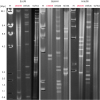1. Davison AJ, Eberle R, Ehlers B, Hayward GS, McGeoch DJ, Minson AC, Pellett PE, Roizman B, Studdert MJ, Thiry E. The order Herpesvirales. Arch Virol. 2009; 154:171–177.
2. Thiry E, Bublot M, Dubuisson J, Van Bressem MF, Lequarre AS, Lomonte P, Vanderplasschen A, Pastoret PP. Molecular biology of bovine herpesvirus type 4. Vet Microbiol. 1992; 33:79–92.


3. Knipe DM, Cliffe A. Chromatin control of herpes simplex virus lytic and latent infection. Nat Rev Microbiol. 2008; 6:211–221.

7. Heldwein EE, Krummenacher C. Entry of herpesviruses into mammalian cells. Cell Mol Life Sci. 2008; 65:1653–1668.


9. Machiels B, Lété C, Guillaume A, Mast J, Stevenson PG, Vanderplasschen A, Gillet L. Antibody evasion by a gammaherpesvirus O-glycan shield. PLoS Pathog. 2011; 7:e1002387.

10. Dimmock NJ. Mechanisms of neutralization of animal viruses. J Gen Virol. 1984; 65:1015–1022.


11. Dimmock NJ. Multiple mechanisms of neutralization of animal viruses. Trends Biochem Sci. 1987; 12:70–75.

12. Thiry E, Bublot M, Dubuisson J, Pastoret PP. Bovine herpesvirus-4 (BHV-4) infection of cattle. In : Wittmann G, editor. Herpesvirus Diseases of Cattle, Horses, and Pigs. Boston: Springer;1989. p. 96–115.
13. Frazier KS, Baldwin CA, Pence M, West J, Bernard J, Liggett A, Miller D, Hines ME 2nd. Seroprevalence and comparison of isolates of endometriotropic bovine herpesvirus-4. J Vet Diagn Invest. 2002; 14:457–462.


14. Verna AE, Manrique JM, Pérez SE, Leunda MR, Pereyra SB, Jones LR, Odeón AC. Genomic analysis of bovine herpesvirus type 4 (BoHV-4) from Argentina: high genetic variability and novel phylogenetic groups. Vet Microbiol. 2012; 160:1–8.


15. Reed LJ, Müench H. A simple method of estimating fifty percent endpoints. Am J Hyg. 1938; 27:493–497.
16. Franceschi V, Capocefalo A, Ravanetti L, Vanderplasschen A, Gillet L, Cavirani S, van Santen VL, Donofrio G. Bovine herpesvirus 4 immediate early 2 (Rta) gene is an essential gene and is duplicated in bovine herpesvirus 4 isolate U. Vet Microbiol. 2011; 148:219–231.


17. Dubuisson J, Guillaume J, Boulanger D, Thiry E, Bublot M, Pastoret PP. Neutralization of bovine herpesvirus type 4 by pairs of monoclonal antibodies raised against two glycoproteins and identification of antigenic determinants involved in neutralization. J Gen Virol. 1990; 71:647–653.


18. Essmail M, Baker D, Collins J, Vandewoude S, Salman M, Hegazy AA. Dot immunobinding assay for detection of bovine herpesvirus 4 antibodies in rabbits. J Vet Diagn Invest. 1999; 11:237–239.


19. Zeippen C, Javaux J, Xiao X, Ledecq M, Mast J, Farnir F, Vanderplasschen A, Stevenson P, Gillet L. The major envelope glycoprotein of murid herpesvirus 4 promotes sexual transmission. J Virol. 2017; 91:e00235-17.

20. Thome M, Schneider P, Hofmann K, Fickenscher H, Meinl E, Neipel F, Mattmann C, Burns K, Bodmer JL, Schröter M, Scaffidi C, Krammer PH, Peter ME, Tschopp J. Viral FLICE-inhibitory proteins (FLIPs) prevent apoptosis induced by death receptors. Nature. 1997; 386:517–521.


23. Donofrio G, Cavirani S, Taddei S, Flammini CF. Activation of bovine herpesvirus 4 lytic replication in a non-permissive cell line by overexpression of BoHV-4 immediate early (IE) 2 gene. J Virol Methods. 2004; 116:203–207.


24. Tebaldi G, Jacca S, Montanini B, Capra E, Rosamilia A, Sala A, Stella A, Castiglioni B, Ottonello S, Donofrio G. Virus-mediated metalloproteinase 1 induction revealed by transcriptome profiling of bovine herpesvirus 4-infected bovine endometrial stromal cells. Biol Reprod. 2016; 95:12.













 PDF
PDF Citation
Citation Print
Print




 XML Download
XML Download